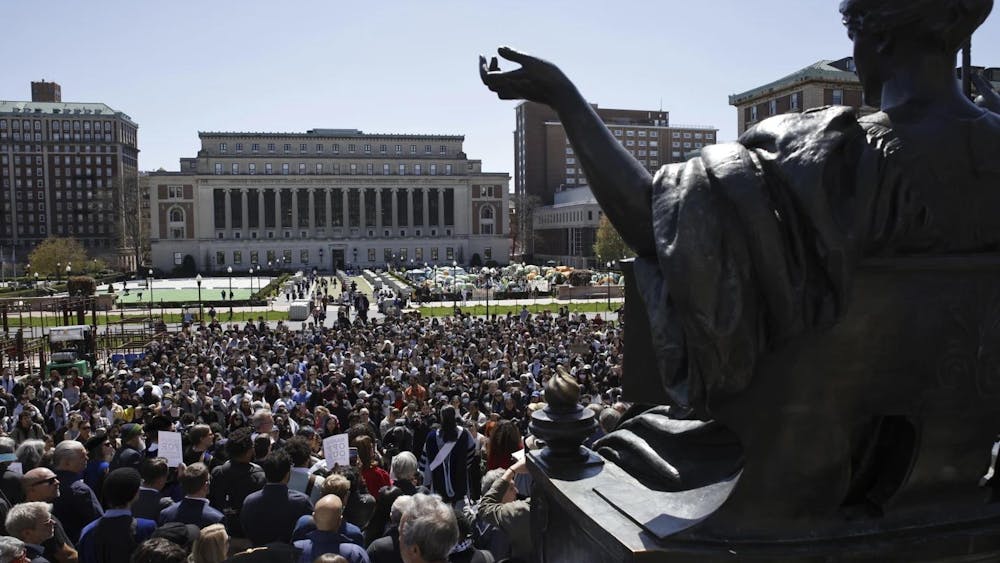Just weeks before receiving his master’s degree from the Notre Dame School of Architecture earlier this year, James Lenahan learned he had won the Papal Sanctuary Design Contest, a competition held by the Archdiocese of Philadelphia to design the sanctuary in which Pope Francis will celebrate Mass during his first visit to the United States later this month.
Lenahan’s submission — only recently announced to the public as the winning entry — will inspire the final design of the sanctuary to be constructed in front of the Philadelphia Museum of Art for the closing Mass of the eighth World Meeting of Families on Sept. 27.
“It was just an incredible honor to have been selected and a really amazing thing for [me], as a student at the time, to contribute to this incredible, historic event,” Lenahan said.
Lenahan said he specifically tailored his design to reflect the mission of the World Meeting of Families, which according to a press release by the Archdiocese of Philadelphia is “to strengthen the sacred bonds of family across the globe and highlight its intrinsic value to the good of society.”
There were relatively few contest requirements, and the majority of the regulations concerned the physical dimensions of the sanctuary and the inclusion of elements such as an altar, the pope’s chair, a lectern and an ambo. Thus, Lenahan said he had considerable freedom to experiment with ideas for his design.
“It was a little bit of a challenge because we had ideas of what was required for the competition, but other than the basic elements, it was kind of open-ended in terms of what they might be looking for,” he said. “In some sense, in design that can be challenging, just in terms of having a completely blank slate.”
Receiving little guidance from the competition itself, Lenahan said he turned to previous examples of large Papal Masses — such as Pope John Paul II’s 1979 Mass in Chicago — for inspiration. He said his ultimate goal was to create “something that would be harmonious with what the site was, the shape of the site.”
Taking into account a variety of practical considerations – foremost among these the estimated crowd size of 1.5 million – Lenahan said he eventually decided to elevate the sanctuary in order to make it more visible.
He also said he settled upon a traditional style for his design, in keeping with the classical façade of the Philadelphia Museum of Art which will provide the backdrop for the Mass.
“The classical has a great deal of beauty that can enlighten the sense of the sacred to a Mass even when it’s an outdoor setting,” he said.
According to Samantha Salden, assistant dean of the graduate programs in the School of Architecture, Lenahan’s implementation of a classical design was particularly fitting because of the Notre Dame architecture program’s emphasis on classical and traditional architecture.
Salden, who also served as Lenahan’s graduate advisor, said Lenahan came to Notre Dame “eager to expand his understanding of classical architecture.”
“[He] felt a passion for tradition and for doing good things for communities, whether that be within an institution or a neighborhood or a broader community,” Salden said. “He is a very unassuming person, very quiet, but very talented.”
In addition to the prize money associated with the award, Salden said Lenahan will receive countless benefits from winning the contest.
“It’s quite prestigious,” she said. “The fact that it is going to have an international audience, not just a national audience, with an event of this scale is hugely gratifying for Jim and will serve him well for years to come.”
And beyond its personal impact on Lenahan, Salden said the award is significant because it highlights the ability of architectural design to alter people’s perceptions.
“Architecture is a vibrant and important part of our everyday experience,” she said. “What we do is not just about putting up structures that are expressive of ourselves personally, but to be a great architect you have to be able to respond to the community that is using this structure, this building.”
Like Salden, Lenahan said he recognized the award to be a formative milestone in his career as an architect.
“It was a great opportunity that was offered based on my studies at Notre Dame, and I feel fortunate that I had some of the tools through studying there that allowed me to participate,” Lenahan said.
“It is incredibly humbling and I just hope that [my design] will be a successful setting for this event.”













